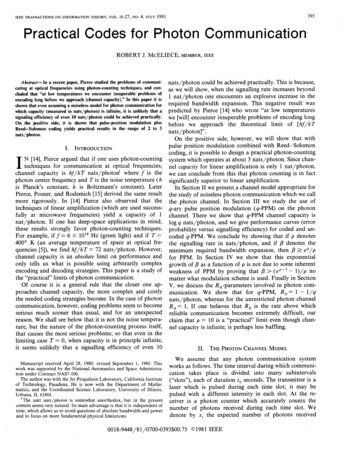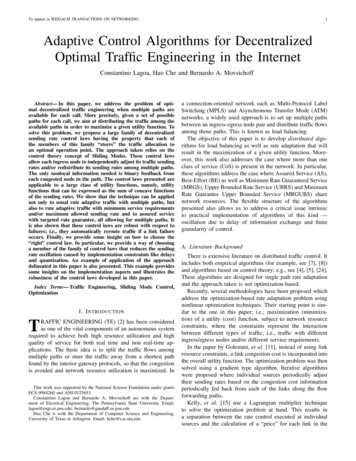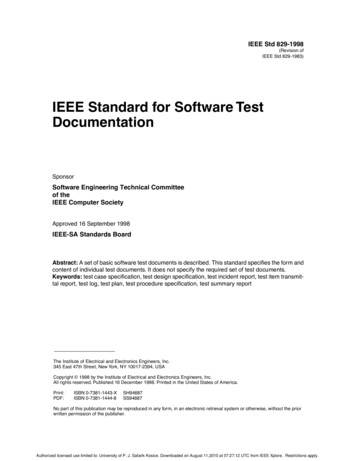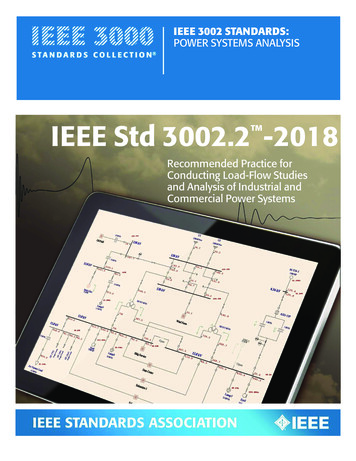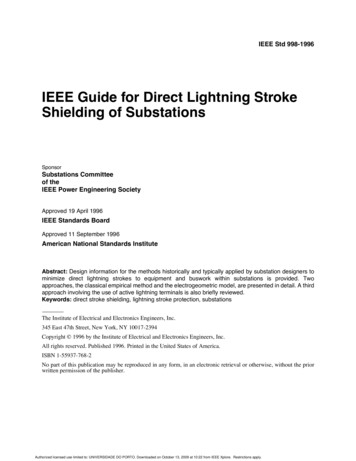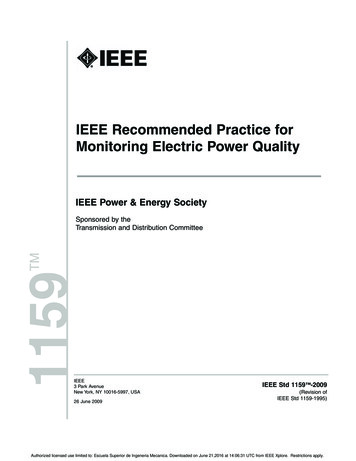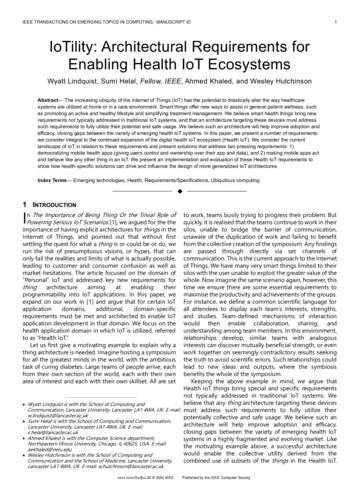
Transcription
IEEE TRANSACTIONS ON EMERGING TOPICS IN COMPUTING, MANUSCRIPT ID1IoTility: Architectural Requirements forEnabling Health IoT EcosystemsWyatt Lindquist, Sumi Helal, Fellow, IEEE, Ahmed Khaled, and Wesley HutchinsonAbstract— The increasing ubiquity of the Internet of Things (IoT) has the potential to drastically alter the way healthcaresystems are utilized at home or in a care environment. Smart things offer new ways to assist in general patient wellness, suchas promoting an active and healthy lifestyle and simplifying treatment management. We believe smart health things bring newrequirements not typically addressed in traditional IoT systems, and that an architecture targeting these devices must addresssuch requirements to fully utilize their potential and safe usage. We believe such an architecture will help improve adoption andefficacy, closing gaps between the variety of emerging health IoT systems. In this paper, we present a number of requirementswe consider integral to the continued expansion of the digital health IoT ecosystem (Health IoT). We consider the currentlandscape of IoT in relation to these requirements and present solutions that address two pressing requirements: 1)democratizing mobile health apps (giving users control and ownership over their app and data), and 2) making mobile apps actand behave like any other thing in an IoT. We present an implementation and evaluation of these Health IoT requirements toshow how health-specific solutions can drive and influence the design of more generalized IoT architectures.Index Terms— Emerging technologies, Health, Requirements/Specifications, Ubiquitous computing—————————— ——————————1 INTRODUCTIONThe Importance of Being Thing Or the Trivial Role ofIPoweringSerious IoT Scenariosnto work, teams busily trying to progress their problem. Butquickly, it is realised that the teams continue to work in theirsilos, unable to bridge the barrier of communication,unaware of the duplication of work and failing to benefitfrom the collective creation of the symposium. Any findingsare passed through directly via set channels ofcommunication. This is the current approach to the Internetof Things. We have many very smart things limited to theirsilos with the user unable to exploit the greater value of thewhole. Now imagine the same scenario again, however, thistime we ensure there are some essential requirements tomaximise the productivity and achievements of the groups.For instance, we define a common scientific language forall attendees to display each team’s interests, strengths,and studies. Team-defined mechanisms of interactionwould then enable collaboration, sharing, andunderstanding among team members. In this environment,relationships develop, similar teams with analogousinterests can discover mutually beneficial strength, or evenwork together on seemingly contradictory results seekingthe truth to avoid scientific errors. Such relationships couldlead to new ideas and outputs, where the symbiosisbenefits the whole of the symposium.Keeping the above example in mind, we argue thatHealth IoT things bring special and specific requirementsnot typically addressed in traditional IoT systems. believe that any thing architecture targeting these devicesWyatt Lindquist is with the School of Computing andCommunication, Lancaster University, Lancaster LA1 4WA, UK. E-mail: must address such requirements to fully utilize theirw.lindquist@lancaster.ac.ukpotentially collective and safe usage. We believe such anSumi Helal is with the School of Computing and Communication,architecture will help improve adoption and efficacy,Lancaster University, Lancaster LA1 4WA, UK. E-mail:closing gaps between the variety of emerging health IoTs.helal@lancaster.ac.ukAhmed Khaled is with the Computer Science department,systems in a highly fragmented and evolving market. LikeNortheastern Illinois University, Chicago, IL 60625, USA. E-mail:the motivating example above, a successful architectureaekhaled@neiu.eduwould enable the collective utility derived from theWesley Hutchinson is with the School of Computing andCommunication and the School of Medicine, Lancaster University,combined use of subsets of the things in the Health IoT.[1], we argued for the theimportance of having explicit architectures for things in theInternet of Things, and pointed out that without firstsettling the quest for what a thing is or could be or do, werun the risk of presumptuous visions, or hypes, that canonly fail the realities and limits of what is actually possible,leading to customer and consumer confusion as well asmarket hesitations. The article focused on the domain of“Personal” IoT and addressed key new requirements bility into IoT applications. In this paper, weexpand on our work in [1] and argue that for certain quirements must be met and architected to enable IoTapplication development in that domain. We focus on thehealth application domain in which IoT is utilized, referredto as “Health IoT.”Let us first give a motivating example to explain why athing architecture is needed. Imagine hosting a symposiumfor all the greatest minds in the world, with the ambitioustask of curing diabetes. Large teams of people arrive, eachfrom their own section of the world, each with their ownarea of interest and each with their own skillset. All are set Lancaster LA1 4WA, UK. E-mail: w.hutchinson@lancaster.ac.ukxxxx-xxxx/0x/ xx.00 200x IEEEPublished by the IEEE Computer Society
2IEEE TRANSACTIONS ON EMERGING TOPICS IN COMPUTING, MANUSCRIPT IDOtherwise, each thing will have its offering in isolation. Werefer to this figure of merit in such architectures as IoTilityor the ability to increase the collective utility of the HealthIoT.In section 3, we describe requirements for Health IoTthat we broadly categorize into “device interactivity” and“user interactivity”. In the former we address requirementsthat enable thing-to-thing interaction and autonomousinter-relations. In the latter, we address requirements foruser-thing interactions that must be met to ensure proper,meaningful and safe use of the devices, the empowermentand enablement of users to easily use the devices, and theestablishment of trust between the user and the Health IoTelements. In section 6, we present a high IoTilityarchitecture for Health IoT emphasizing only parts that aremost relevant to the requirements presented in section 3through 5. This includes the IoT-Device DescriptionLanguage (IoT-DDL), a machine- and human-readablelanguage to provide the basis of cross communication andthe establishment of inter-thing relationship. Section 7presents implementation and evaluation of parts of thearchitecture. In this section, we present two uniqueframeworks/toolsets that meet the architecturalrequirements. The Runtime Development Environment(RIDE), allows end-users to dictate the high-levelfunctionality of Health IoT applications they easily composeout of existing Health IoT devices; and the Mobile Apps AsThings (MAAT) framework, allows developers of healthmobile apps to utilize actionable keywords (AKWs) toenable the future IoTility of their mobile application,without the having to predict or plan for all potential futureinteractions. We conclude the paper in section 9.2 RELATED WORKManaging an IoT ecosystem in a specialized environmentrequires a structured architecture fit for the job. Works suchas NIST’s Network of Things (NoT) [2] propose afoundational design for an IoT system. NoT defines a set ofprimitives describing the functionality of individual sensorsand groups of devices, as well as how they maycommunicate. Laplante et al. [3] present another structuredapproach, specifically targeting IoT healthcare systems. Theauthors consider various use cases, such as managingdementia, and describe a set of privacy and safetyrequirements for a Health IoT system.Catarinucci et al. [4] offer an architectureimplementation, again targeting healthcare systems, thatfocuses on the interoperation of a variety of wirelessprotocols to collect and monitor patient data in a smarthospital scenario. The data can be accessed uniformly byhealthcare providers, or monitored to send pushnotificaions to caregivers on critical sensor events. OurAtlas architecture [5] is another specialized IoT system,focusing on peronal IoT and the potential for interactionbetween devices. This architecture is described in furtherdetail in section 6.Facilitating interactions between IoT devices and thingsis a primary goal of many of these systems. The SocialInternet of Things (SIoT) [6] describes group of smart objectas a social network to mimic human behavior. Devices formsocial relationships over similar functionalities, vendors, orphysical locations. If This Then That (IFTTT) [7] in the cloudand Things Talk to Each Other (TTEO) [8] on the deviceallow similarly allow users to compose services into rulebased applications through a set of “if-then” triggers. Theseforms of interaction are expanded on in section 4.2.Another goal of these IoT systems focuses on enablinginteroperable usage of heterogenous devices. Initiativessuch as the Continua Design Guidelines [9] provide a set ofstandards withanopenimplementationthatmanufacturers can follow in their health devices, creating auniform base API across brands. In a similar fashion, theSolid [10] and MyData [11] services aim to improve healthdata accessibility, utilizing concepts such as decentralizedstorage and standardized formats. The importance of thesefeatures is discussed in section 4.1.Within these goals, trust, privacy, and security also playa major role. NIST’s NoT considers thing security at eachlevel of their architecture, from sensors to usercommunication and triggers. Mahale et al. [12] present anaccess control system that calculates trust values based onparameters captured from a smart space. These trust valuescan then be used to manage user identity. Lomotey et al.[13] create a health information system to associate useridentity with the various data streams gathered fromsensors in a smart space. Section 5.3 furher details theseissues.3 REQUIREMENTS FOR HEALTH IOTWe identify a set of requirements we consider highlyrelevant to future thing architectures targeting Health IoTsystems. We do not claim to provide a complete list ofthese requirements, but a selection of those we believe willallow such a thing architecture to maximize its IoTility inutilizing new digital health devices and the interactions andapplications they enable. We group these requirementsinto two categories: 1) device interactivity, or how a devicecan expose its capabilities programmatically to applicationdevelopers as well as cybernetically to other devices in asmart space, and 2) user interactivity, or how a deviceenables and guides an end user to properly (and safely) useit.When considering the significance of deviceinteractivity, one may reflect on the state of health dataplatforms such as Apple HealthKit [14]. This platform allowsa user’s phone to interact with supported devices, storingand displaying data in a unified interface. A user is providedwith a level of assurance when buying a supporteddevice—it will “just work” through its integration in theHealthKit app. However, this assurance hinges on thisplatform support: a device supporting only Google Fit orSamsung Health, for example, will be unable to interactwith other HealthKit devices. These platforms offer usersmore control over their data and devices, but only in thecontext of their supported and closed ecosystem.When considering the importance of user interactivity,one should look towards the plethora of personal healthdevices collecting precision data, which may generate
WYATT LINDQUIST ET AL.: IOTILITY: ARCHITECTURAL REQUIREMENTS FOR ENABLING HEALTH IOT ECOSYSTEMSerroneous or noisy data if used improperly orinaccurately—often a challenging task for the user. Forinstance, the Kardia [14] device can collect anelectrocardiograph (EKG) sequence as the user places twofingers on each side of the device; proper finger placementis critical in receiving a quality reading. To facilitate this, theKardia app exposes a familiar “signal strength”-style metric(figure 1), providing at-a-glance, feedback and guidance onfinger placement to the user. Unfortunately, Kardia is anoutlier in this regard; most devices lack the facilities todetect or react to inaccuracies and accept such interactionsunconditionally.Fig. 1. The Kardia device and app interface.To highlight both of these requirements, we consider thefollowing near-future scenario throughout this section:following consultation with their physician, a patient’s riskof diabetes is highlighted as significantly raised.Suggestions are made for the patient to make lifestyleadjustments to reverse this risk. Just as medicine isprescribed, the physician also prescribes various IoTdevices for the patient to obtain. The patient fulfills theprescription for a body-weight and body-fat sensing scale,a blood pressure monitoring device, and a glucose monitor.The patient chooses running as a means of exercise and sopurchases smart soles to compliment the community ofdevices, as well as a pulse oximeter and a temperaturemonitor advertised as a more accurate measure ofmetabolic rate. Finally, the patient downloads a dietingmobile app to his smartphone. We use the elements of thisscenario in the next sections to derive and explain ourrequirements for Health IoT.4 DEVICE INTERACTIVITYA thing must have the ability to send information andreceive commands before it can be useful in a digital healthsmart space. Many things have no physical user interfaceand limited potential for physical configuration; instead,they must utilize a more feature-complete parent device(such as an edge device or mobile phone) to act as thepoint of interaction with the user. A thing relies on thisability to interact with a parent device to fully represent itscapabilities. To do this, the underlying thing architecturemust provide not only hardware and software interfaceswithin the thing, but also the basis for communication withother devices. This architecture therefore becomes critical3for the successful integration of that thing within a smartspace.To achieve this goal across the wide range of potentialdevices in health IoT, an architecture must be cognizant ofhow things may manifest themselves. For example, a thingmay be a simple sensor, a higher-level device with a RESTAPI, or even a full software system such as a mobileapplication. All of these thing types may perform the samefunctionality, such as reading a sensor value; however, thesimilarities stop there. Beyond utilizing different protocols,these things may perform their interactions in an entirelydifferent way. The sensor thing may continuously emit itsvalue as an electrical signal, the REST API device mayperform its reading when an endpoint is invoked, and themobile app may record a measurement based on thecontext of the phone's user's actions.These different possibilities may be viewed as different"tiers" of interaction within the same system, where a thingarchitecture may always operate on, say, the REST API levelof the interaction. However, with new devices constantlyentering the IoT space, it is unreasonable to assume theywill all operate in the same manner and expose the samecapabilities. A health thing may not use a physical sensoror may be entirely represented within a mobile application.Instead, a thing architecture targeting digital health shouldconsider the potential for inter-thing interaction across allof these forms.4.1 Common Programming Interfaces (APIs)Regardless of the context of its interactions, a thing mustexpose some form of API to allow it to communicate withthe whole of the smart space. We believe the availabilityand utility of such an API is a key piece in determining howeasily a new thing may be integrated into an existing smartspace. Without an API, there is likely little to no way for asmart space to interact with said device. Rather, only thefunctionalities and system the device was explicitlyprogrammed to utilize can be exploited.Many devices in the current digital health landscapetend towards this pattern [14]. Lacking a true independentAPI, the device is tied to a specific ecosystem or subsetthereof, creating "silos" of functionality segmentedbetween manufacturers and vendors. While the potentialfor interaction inside the silo may be rich, such interactionscannot take place with devices outside that silo. If a userwants to fully utilize the potential of their smart space, theymust stay within a silo of compatible devices. Such asituation is especially problematic when a specific devicetype does not exist within a user's chosen silo; the user isforced to use a device with potentially decreasedfunctionality, or consider using a different silo.Such an effect can be seen within the ecosystem ofcompanion mobile apps for health IoT devices. A user witha collection of smart devices likely has a similar collectionof apps on their mobile phone, with each device requiringits specialized app to make full use of its features. Thenatural progression of these silos is an ever-increasingnumber of apps on a user's phone as they acquire moredevices: making it harder for the user to find theinformation they want, and making tasks such as showing
4IEEE TRANSACTIONS ON EMERGING TOPICS IN COMPUTING, MANUSCRIPT IDmultiple measurements from different devices at oncemore complicated.Of course, eliminating these silos through a singlestandardized API is unlikely; vendors will always want toprioritize interactions between their own devices. However,even a limited subset of API compatibility, such as thatdefined by the Continua guidelines [9], could greatlyimprove a thing's ability to interact with its smart space.Consider the patient’s temperature sensor from thescenario at the start of the section. Such a device is meantto be attached directly to the body, meaning it likely haslittle in terms of a physical interface (i.e., no integrateddisplay to show the current temperature), and limitedcapacity for physical interaction (i.e., a sole button fortoggling power).The temperature readings and any neededconfiguration are instead exposed through a companionmobile app, which the user is required to download to usethe sensor. Imagine, however, a user with accessibilityconcerns, where the companion app does not workproperly on their specialized device. Without the app, thehealth device cannot be used properly, even though thehardware itself is functioning. However, in this case, thedevice exposes a minimal standard API with basicfunctionality. Perhaps the user holds their mobile devicenear the sensor, and receives usage instructions as well asthe ability to perform a basic read from the sensor (therebyreceiving their body temperature as desired). Moreadvanced configuration features are not exposed throughthis API, but the user is still able to use the device, despitebeing unable to use the app.Introducing more open APIs, however, does haveimplications regarding the safety and security of thesesmart devices [15]. Such concerns must also be carefullyaddressed; once a device provides data and receivescommands more openly, the thing architecture must “pickup the slack” and ensure these APIs are not abused. Evenwhen the API is being used properly, health devices mustconsider who is using the API; a primary user may be ableto see readings from a device through its API, but thesereadings should not be available freely. These are otherimportant requirements for the health IoT that arediscussed in later sections.We believe at least a minimal shared API is essential inmitigating the segmentation of thing devices. Ensuringfunctionality across a larger portion of users, in addition toproviding users with more control over their data (such aswith Solid
IEEE TRANSACTIONS ON EMERGING TOPICS IN COMPUTING, MANUSCRIPT ID 1 IoTility: Architectural Requirements for Enabling Health IoT Ecosystems Wyatt Lindquist, Sumi


